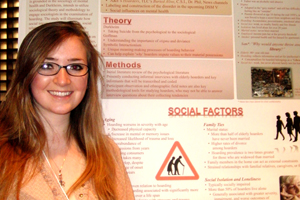Social Sciences
A Sociological Look at Hoarding

As a sophomore, Emily Parker, BA sociology ’12, interned with a social worker in a nonprofit* that worked with elderly tenants of apartment buildings or subsidized housing in the District to help prevent eviction, mainly due to hoarding issues. “I went into all sorts of hoarders’ houses, and I felt that there was something sociological underlying these experiences,” she says. “I was seeing all of these themes emerging in the people I was working with.”
Even after her internship officially ended, Parker wanted to dig deeper, and in sociology professor Michael Bader’s Health and the City course, she was able to do just that. “I worked with him on my research, and he thought that the topic of hoarding in the elderly population, particularly in low income, urban environments, was appropriate for the Eastern Sociological Society annual conference,” says Parker. “He suggested that I submit an abstract.”
Her abstract was accepted, and at the end of February, Parker presented her poster in New York at the conference. “A lot of people were really excited about the topic and couldn’t believe when I told them that there’s never been any sociological research on it,” she says. “I just kind of stumbled upon it through this internship. It just fell into my lap.”
Her poster won the Eastern Sociological Society Undergraduate Research Award, though Parker is modest about the accolade. “I think my poster won not because I’ve learned anything more, but because I’ve found this really unique issue that’s relevant to our times, especially with increasing consumerism,” she explains. “People are having a lot of issues with how to manage their belongings.”
The study of hoarding is so new that it’s not even included as its own disorder in the diagnostic manual for psychologists yet. “This only really came forward in the 1990s,” says Parker. “My research is trying to initiate a sociological understanding of the subject.”
Part of the problem is that there’s no accepted explanation of hoarding yet. “A lot of people are compulsive buyers or savers. That’s part of it,” Parker explains. “When it becomes hoarding, in terms of the definition, there’s an important element of impairment of the ability to perform daily life activities.”
Parker wanted to frame the subject as less of an individual psychological problem and focus more on the larger societal factors that manifest themselves in individual behaviors. “These were factors like trauma in one’s life, social isolation, lack of family ties, unemployment, socioeconomic status, and especially aging and how aging in our society in particular can precipitate hoarding behavior,” she explains.
While hoarding isn’t exclusive to lower income population, it’s certainly more apparent. “It’s more obvious if you don’t have the means to store your things or pay for someone to clean up your apartment, or if you don’t have someone coming in to inspect,” says Parker. “If you own a mansion, then people probably won’t know if you hoard.”
During her internship, she particularly noticed that many of the hoarders she worked with were also veterans. “I saw a lot of post-traumatic stress disorder, and I found that to be sociologically significant in terms of how veterans are affected later on in life,” says Parker. “Oftentimes insecurity manifests itself in collecting and holding onto items and not being able to throw away because the feeling of trauma reemerges. These items help them to focus on something else.”
Though her internship is long finished, she’s still working with the nonprofit to continue her research for her senior capstone project. “For me, it’s more about understanding why these things are important to people,” she says. “It was just incredibly fascinating to me—the meanings and value they imbued onto their items.”
While Parker sees the worth of her research as contributing to the sociological community, it was more about the subjects of the study for her. “I got to learn so much about these people’s lives,” she explains. “I really care about the clients that I work with. I really wanted to give them a voice through this project.”
* Name of nonprofit withheld for confidentiality